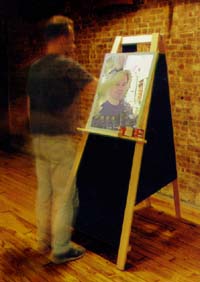
Easel 1998
Description
"Easel" looks like a large paining easel with a blank canvas stretched
on a frame mounted to it. The painter uses a small paintbrush in the same manner
a painter would. Instead of solid colors the brush applies live video from cameras
positioned nearby. Each new stroke of the brush brings a new coat of "current
video" to the canvas. The painter can select between a few live video sources
by dipping the paintbrush into a few paint cans that are mounted on the easel. The
computer that runs the "Easel" software is hidden in the background and
there is no computer screen in sight.
Technically
In the heart of "Easel" are a video camera and a video projector aimed
at the canvas. The camera is sensitive to infrared light only, and the projector
projects the computer screen. The paintbrush's bristles are made of fishing wire
that serve as fiber optics and emit infrared light through the canvas. The infrared
light is captured by the camera that transfers it to the computer via a video digitizing
board. A second video camera is connected to the computer and inputs a picture of
the surrounding view. The computer mixes both video sources according to a few simple
algorithms, and the result is sent through the projector back to the canvas. The
effect is an illusion that the images are being applied by the brush. Sensors in
the paint cans switch between video sources for the input of the second video board.
Aesthetically
"Easel" is interesting aesthetically both as a work in progress and as
a final piece. As a work in progress every new stroke of the brush brings a new coat
of video to the canvas, since there is no erasing, the background is always some
previous video. The changing proportions between new and old strokes change the viewers
perception of positive and negative spaces. As the piece is completed various patches
of video are blend into a soft collage with multiple levels of transparency, a hint
of three dimensionality is present due to the layering effect of the coats of video.
Artistically
The content of a piece painted with "Easel" is not set. However the placement
of the video sources does imply a set of expanding circles around the painter. The
first circle is the closest. It is a camera pointed at the artist allowing him/her
to portray themselves or any objects near by. The second circle is a video camera
pointing at the surrounding environment such as the room. The third circle is a live
feed from TV or a camera pointed out the window. Using these three inputs the artist
can create a picture that reflects a certain moment in time at a certain location
and state of mind.
Philosophically
No one starts from a blank canvas, each piece builds on the work of previous artists.
This is something we are used to in the "real world" but seldom see in
the "digital world"
The canvas is a tool that composites content. The artist does not have to create
all the material from scratch, and some content is supplied, however the freedom
within that content is great and allows for personal expression.
The Easel has no user interface in the conventional computer way. All aspects of
it perform as one would expect, the canvas displays the work, the paintbrush applies
the paint, and the paint cans select the colors. By eliminating any uncertainty regarding
the operation of the tool, the painters are free to concentrate on the painting itself,
while the computer adds its calculation power seamlessly.
Since "Easel" requires no "drawing talent" to create a rich and
interesting piece, most people are not anxious about using it, and are rewarded by
the richness of the result.
All hardware used is off-the-shelf and easy to find. It is the software and the specific
setup that make the result interesting.
Participation
One person can paint at a time and probably 10-20 more can observe and participate
passively by having there pictures incorporated in the piece. The resulting images
can easily be broadcasted over the internet using web cam technology, and then thousands
of people can see the live work as it is created.
Picture of the Easel. Click to enlarge
Quicktime movie showing the Easel in action. Click to play.
Pictures of collages people have created with the Easel. Click to enlarge